The Golden Age of IBM Advertising
Big Blue's classic midcentury campaigns for "card-programmed calculating machines," newfangled typewriters, and other miracles of technology.
Harry McCracken, Technologizer
Back in May, we told you about some industrial films that IBM commissioned from the Muppets in the 1960s. The decade before that, the office-equipment giant was a major advertiser in glossy mass-circulation magazines such as LIFE.Today, those ads are a fascinating, evocative trip back to a world in which technology, work, and workplaces were radically different. Yes, there was a time when the typical piece of business correspondence was a snail-mail letter typed by a secretary on a typewriter which might or might not have been electric-and which had no provision for correcting errors.
(Click to enlarge any images that follow)
Back in the 1950s, IBM was just getting into the computer business, many companies still needed to be convinced that electric typewriters weren't a technological boondoggle, and slide rules were still essential equipment. And the American workplace-at least as depicted in magazine ads-had what we'd now consider a distinct Mad Men edge to it.
Mix yourself the cocktail of your choice, settle into your Eames chair, and return with us now to the era of mainframes and secretarial pools to rediscover these vintage IBM ads fromLIFE and other publications.
February 1950
In the pre-transistor world of 1950, vacuum tubes were still exciting, futuristic technology. IBM hadn't quite started selling general-purpose computers yet; the gadgetry shown in this ad included calculators and time clocks.
The company liked to show atomic imagery in its ads in the 1950s-it, too, was exciting and futuristic.
June 1951
I don't think IBM expected anyone who saw an ad like this inLIFE to rush out and buy an Electronic Calculator. It just wanted to burnish its image as a leading maker of super-sophisticated scientific equipment-one that had already sold thousands of Electronic Business Machines.
Here we have a hundred and fifty engineers-all white guys with receding hairlines-somberly contemplating their slide rules and confronting the fact that the IBM Electronic Calculator threatens to put them out of work.
The woman who showed off the calculator in the previous ad has been replaced by a man; from here on out, the females in 1950s IBM ads would be secretaries.
She's happy, all right, but she also appears to be typing with one hand while standing nowhere near the typewriter and mugging at the camera. Just think how productive she could be if she chose to type in a more mundane style.
We all press Return keys every day-hey, even the iPad has a virtual one-but it's startling to realize that they were once an amazing breakthrough. If you used a manual typewriter-in 1954, lots of folks did-you had to shove the carriage back yourself.
I don't know where Big Blue got the numbers it quotes in this ad-especially the factoid about the average typist returning the carriage 268,000 times a year-but I like them.
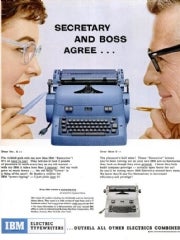 June 1955
June 1955
IBM, logically enough, came to the conclusion that it needed to convince both secretaries (who did the typing) and bosses (who paid the bills and took the credit) that it made the best typewriters. I can't look at this ad (with "Miss S." and "Mr. R." making goo-goo eyes and their letters' references to love and pleasure) without constructing an unwholesome backstory in my mind.
IBM electric typewriter ads often showed the machines conspicuously unplugged-in order to remind businesses with manual typewriters that IBMs had a plug, I guess.
October 1955
Another "Secretary and Boss" ad, with separate pitches to "the men who sign the letters" and "the girls who type the letters." It was a simpler time.
This ad's so inspiring it almost makes me wish I'd been around in 1956 to seek a "provocative" job as an IBM field technician. I love the reference to "the world's largest computer"-it wouldn't be that much longer before the only size-related bragging that computer companies did would involve miniaturization, not enormity.
The machine in question was the IBM 702-an archetypal room-filling mainframe that used magnetic tape rather than familiar punch cards. It was the company's first real commercial computer, and it was already out of production when this ad ran.
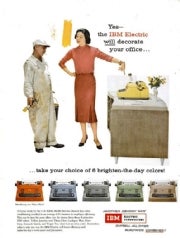 November 1956
November 1956
You thought Steve Jobs invented the idea of gizmos in multiple colors? More than forty years before polychromatic Macs, IBM offered typewriters in six scintillating hues: Yellow Jasmine, Titian Glow, Larkspur Blue, Dove Grey, Cascade Grey, and Tropic Tan. I'm not sure whether this lady got an IBM to match her flowers or vice versa.
Note also that workmen were apparently allowed to smoke in the office in 1956.
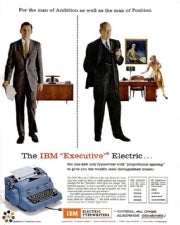 February 1957
February 1957
Here's how you knew you'd made it in American business in 1957: You got a perky secretary, a fancier lamp, and a painting (of yourself?-I can't quite tell) behind your desk. You also had to wear a three-piece suit and take up using a pocket watch. Oh, and being male was pretty much mandatory.
The IBM typewriter in this ad was an impressive piece of technology-the only available model with proportionally-spaced characters. IBM bragged that it permitted the preparation of right-justified documents. (One catch: They had to be typed twice, using special variable-width space bars.)
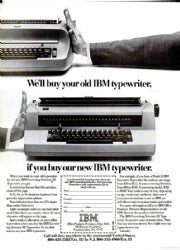 December 1980
December 1980
Fast-forward twenty-two years. By the early 1980s, the typewriter was a dead gadget walking-not just because of the personal computer (IBM would announce its first PC a little over six months after this ad appeared) but also because of word processors such as those popularized by Wang Labs in the 1970s.
This ad shows just how incredibly mature typewriters had gotten: IBM couldn't claim that the Selectric III would boost your career or impress your customers. Instead, it had to try and get prospective buyers jazzed about refinements such as non-reflective keys. It took another eleven years for it to get out of the typewriter business period. Mainframes, however, it still makes.
More tech nostalgia on Technologizer:
How 1940s Whiskey Ads Predicted the Future
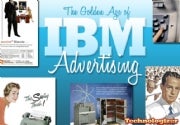

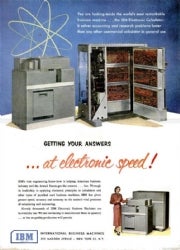
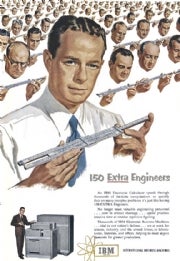
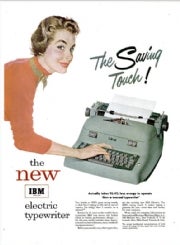

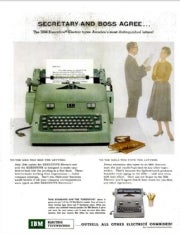

沒有留言:
張貼留言